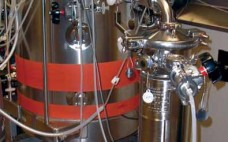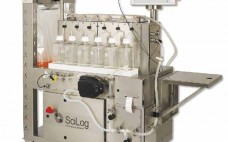Although vaccines and immunotherapies are designed to engage the human immune system in fighting disease, unwanted immunogenicity can be a major problem for protein-based therapeutics. Some patients produce antidrug antibodies (ADAs), which might lead to drug inactivation or adverse effects. Even human and humanized proteins have proven to be surprisingly immunogenic in some cases, suggesting that immune tolerance requires careful consideration in biologic product design. In rushing to deliver new drugs to market, some biotherapeutics developers have overlooked factors that…
2014
Immunoglobulin Fc-Fusion Proteins Part 2: Therapeutic Uses and Clinical Development
The potential therapeutic value of many proteins — including enzymes, receptors, cytokines, blood factors and peptides — can be realized by fusing them to the Fc region of human immunoglobulin G. Of the 46 monoclonal antibody (MAb) and MAb-derivative products approved by the FDA to date as human therapeutics, 10 are Fc-fusion proteins (Table 2). Among approved products, several structural variations are represented (Figure 4). In BPI’s October 2014 issue, Part 1 of this review examined the structure and manufacturing…
Sterilization Effects on Elastomer Characteristics and Functionality in Parenteral Delivery Systems
To drive efficiencies in producing parenteral drug products, manufacturers are using containers and closure components that are received sterile and ready to be introduced into filling lines. The effects of sterilization on the properties of ready-to-use (RU) components must be assessed to ensure proper processing techniques and suitability over the components’ intended shelf lives. Sterile-drug manufacturers must determine the best sterilization method for components based on their respective drug products and processes. Critical areas of risk include potential changes related…
Reducing Timelines in Early Process Development – Using a Multiparametric Clone-Selection and Feed-Optimization Strategy
The market for biopharmaceutical products remains highly attractive to small biotechnology companies and big pharmaceutical corporations alike (1). Most leading market products are made using recombinant technology (2). Pressures are continually increasing on process development groups to reduce development costs and timelines for taking new clinical products forward from product research bench scale into initial clinical evaluation studies. For many years a recognized critical bottleneck in development of products from mammalian cell lines was selection and isolation of stable, high-producing…
Creating Value Through Investment
During my MBA course, Professor Pierre Casse — then at the International Institute for Management Development (IMD) in Lausanne, Switzerland — regularly reminded us that one key to success was constantly finding new ways to “delight and inspire your clients” by creating value. SAFC achieved that objective in its “Overcoming Supply Chain Vulnerability and Lowering Risk in Biopharmaceutical Manufacturing” symposium 17–18th June 2014 in Turnberry, Scotland. Along with a day of industry insight, the event included a visit and tour…
October 2014 Spotlight
RX-360 CHOOSES AUDIT LEADER Rx-360, a not-for-profit international consortium representing the world’s leading pharmaceutical and biotech organizations, announced in June a partnership wherein BSI Supply Chain Solutions would lead its international joint audit program. BSI will work with Rx-360 to streamline the audit process and ensure supplier compliance with quality and security standards through verification audits. Recognizing that globalization complicates quality and security of the supply chain, Rx-360 developed this program to allow multiple companies working with the same business…
Trends in Setting Single-Use Technology Standards
The biopharmaceutical industry now incorporates single-use (SU) technology and systems in most production processes based on cell culture (1, 2). Implementation of such technologies has led to the availability of prepackaged and sterilized systems complete and ready for use with preinstalled mixers and monitoring probes. From upstream process- material preparation through final-product formulation, biopharmaceutical sponsors are increasingly presented with numerous SU solutions that support all major production platforms (3–5). The number of SU materials and suppliers in biopharmaceutical manufacturing has…
Polymer Resins: Building Blocks for Single-Use Bioreactor Components
Single-use manufacturing equipment for the production of certain biological compounds (e.g., recombinant proteins from mammalian cell cultures) makes good sense. Such equipment reduces water and energy use, decreases the need for equipment sterilization and waste treatment, and optimizes space in a manufacturing facility. But consider the plastic resins used to construct the disposable parts of such equipment. In BPI’s April 2014 issue, Tony Kingsbury discussed the fundamentals of how plastics are made. In this second installment of BPI’s series on…
Understanding and Controlling Sources of Process Variation: Risks to Achieving Product Critical Quality Attributes
Biopharmaceuticals include recombinant proteins, vaccines, gene therapies, and drug products derived from stem cell technology. One key characteristic of shared by all biologics is that they tend to be extremely large molecules with complex three-dimensional structures, critical to their functionality. For example, monoclonal antibodies (MAbs) are composed of more than one thousand times larger than a molecule of aspirin (one analogy compares the complexity of a MAb to that of an F16 jet, and the complexity of aspirin to that…
Upstream Efficiencies, Economic Forces, and Changing Technologies Complicate Separation and Purification
When it comes to biotherapeutics manufacturing, downstream processing groups tend to get “dumped on.” Advances in cell lines, bioreactors, and culture media formulations have increased production output, providing both higher expression titers and greater volumes, but the filters and chromatography columns on the downstream side haven’t kept pace. These century-old technologies haven’t evolved as much and are reaching their limits. Regulatory agencies have contributed to innovation stagnation because they are cautious about manufacturing process changes for fear of undermining quality…









